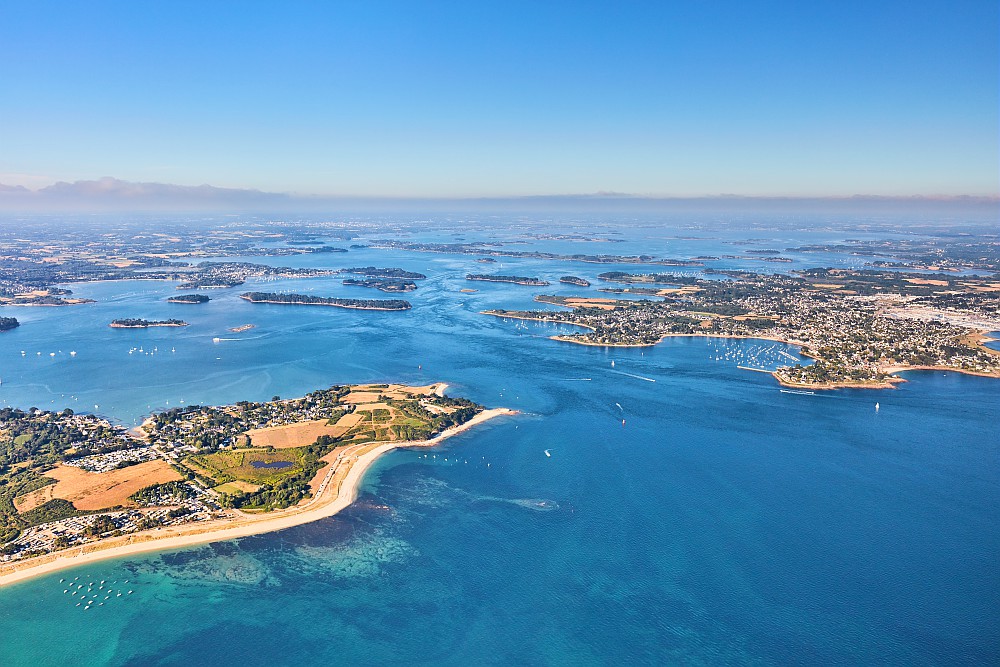
Morbihan is a holiday region par excellence. The climate is milder in Morbihan, the beaches whiter and the sea bluer than elsewhere in Brittany.
Some of the most beautiful places and landscapes in Brittany are in Morbihan. The islands of the Gulf of Morbihan and the Brocéliande forest. The villages of Josselin and Rochefort-en-Terre. The towns of Lorient and Vannes. The menhirs of Carnac and the coast of Quiberon. Who can resist such a fantastic package? Let’s go to Morbihan!
Discover now:
Weather
Like everywhere else in Brittany, the climate in Morbihan is distinctly maritime. Mild winters and not too hot summers characterise the climatic conditions. During the summer months there is seldom too much heat and in winter there is hardly any frost.
There is no shortage of rainfall in the Morbihan region as a whole; statistically, the highest amount of rain falls between December and March. In terms of precipitation, however, there are great differences within Morbihan.
While the north-western parts of Morbihan on the border with Finistère are extremely rainy (1,300 mm per square metre on an annual average), the south is dry in comparison. The Rhuys peninsula, for example, receives an annual average of 700 mm of rain per square metre. Sun-seekers have good prospects on the south coast, where the most hours of cloudless sky are measured at around 1,900.
Microclimates are found in particular on the Quiberon and Rhuys peninsulas and on Belle-Île.
Travelling
As in the rest of Brittany, there is no toll motorway in Morbihan. The main roads in Morbihan are the N24 (Rennes – Ploërmel – Lorient), the coastal N165 linking Nantes – Vannes – Lorient – Quimper, and the north-south N166 between Ploërmel and Vannes, which leaves the N24.
Distances by car:
- Lorient – Vannes: approx. 45 minutes
- Carnac – Pontivy: approx. 1 hour
- Rochefort-en-Terre – Ploërmel: about 30 minutes
- Auray – Sarzeau: approx. 40 minutes
- Locmariaquer – Port Navalo: about 1 hour
Gulf Of Morbihan
The Gulf of Morbihan, which gives its name to the region, is the biggest attraction in the south of Brittany, which is rich in sights. The gulf is 20 kilometres long in its east-west extension and 15 kilometres wide from north to south. At a narrow point between Locmariaquer and Port Navalo, the inland sea opens onto the Bay of Quiberon, thus connecting the lagoon with the Atlantic.
The highlight are the 42 or so islands in the Gulf of Morbihan. Unfortunately, many of the islands are privately owned and therefore not accessible to visitors. However, with Île aux Moines and Île d’Arz, the two largest islands of the archipelago are open to tourists.
On a small ferry from Quai Port-Blanc in Baden (about 15 kilometres from Vannes), the crossing to Île aux Moines takes about 5 minutes. Then the visitor enters an island that could also be in the southern Mediterranean. Mediterranean flora and fauna and golden sand on the beach almost make you forget that you are in Brittany.
However, as with all popular destinations, visitors have to share the beauty of the island in the Gulf of Morbihan with many other tourists. One way to avoid the crowds is to explore Île aux Moines by bike. The cycle paths are well developed, and there are numerous opportunities to rent bikes.
The smaller, but less crowded Île d’Arz is also worth a trip. The ferry to this island, which is more unspoilt than Île aux Moines, leaves from the Pointe de Conleau in Vannes and takes just under half an hour.
Places Of Interest
Carnac
The megaliths are the most important attraction of Carnac. There are 2,934 menhirs to admire in Carnac, more than anywhere else in Brittany. In addition to the mysterious stones, visitors can admire ornate Renaissance-style buildings and a wonderful 2-kilometre-long beach. As the area near the Gulf of Morbihan is one of the sunniest in Brittany, it is the perfect place to combine a beach and cultural holiday.
Josselin
Compared to the neighbouring Loire-Atlantique region, Brittany is not blessed with an abundance of castles. One exception is the 1000-year-old “Château de Josselin”. The Château de Josselin is just the thing for lovers of architecture from the Gothic and Renaissance eras and, of course, for all those who love extensive and exceptional gardens.
Brocéliande Forest
The heath, trees and springs of the Brocéliande forest form the backdrop for legends about wizards and fairies. The story of King Arthur is probably the most famous of all the legends. The Forest of Brocéliande lies off the coast in the west of Morbihan, the nearest town being Ploërmel.
Rochefort-en-Terre
It is official that Rochefort-en-Terre is one of the most beautiful places in Morbihan, Brittany and even one of the most beautiful villages in the whole of France. Rochefort-en-Terre, 35 kilometres from Vannes, holds the title of “Les Plus Beaux Villages de France”. Outstanding sights are the “Château de Rochefort” and the many houses decorated with flowers throughout the village.
Vannes
The elegant town of Vannes lies on the northern edge of the Gulf of Morbihan. With a medieval festival and a jazz festival, the second largest city in Morbihan is the lively centre of the region.
Images: Comité Régional du Tourisme de Bretagne | © Alexandre Lamoureux
